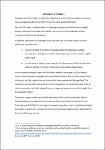The challenge of securing future food production for aquaculture species under environmental change: enhancing physiological performance under environmental stress
| dc.contributor.supervisor | Truebano, Manuela | |
| dc.contributor.author | Abbas, Ahmed Salama Ali | |
| dc.contributor.other | Faculty of Science and Engineering | en_US |
| dc.date.accessioned | 2024-04-10T11:56:51Z | |
| dc.date.available | 2024-04-10T11:56:51Z | |
| dc.date.issued | 2024 | |
| dc.identifier | 10635391 | en_US |
| dc.identifier.uri | https://pearl.plymouth.ac.uk/handle/10026.1/22265 | |
| dc.description.abstract |
Rising sea surface temperatures and ocean acidification present profound challenges for many marine species, leading to cascading effects on ecosystem functionality and food security. Phenotypic plasticity is anticipated to play a key role in helping marine ectotherms maintain performance and acclimate to changes in these global environmental drivers. However, our understanding of phenotypic plasticity in the context of climate change is largely based on short-term studies, with limited ecological relevance, which often overlook some important response modifiers such as environmental context, exposure nature, reproductive modes, and potential trade-offs between fitness components. As a result, the full potential for marine ectotherms to exhibit physiological acclimation within and across generations remains not well understood. This thesis addresses this knowledge gap by investigating the extent of physiological plasticity in key intertidal species, which are crucial for both ecological and commercial purposes, considering such response modifiers. Different species are exposed to ocean warming (OW) and/or ocean acidification (OA) across various life-cycle stages. I first characterize metabolic plasticity in adult intertidal gastropods after exposure to OW and OA, exploring the effects of exposure length (over 12 months) and seasonal dynamics on metabolic responses (Chapter 2). I then assess the cost of thermal acclimation in adults of two gastropods with different reproductive modes, examining the potential trade-off between scope for growth (SfG), reproduction, and survival in relation to reproductive mode and the magnitude of temperature change (Chapter 3). I also compare the effects of two thermal regimes different in their nature (repeated heat shocks vs chronic warming) on thermal tolerance and performance in adults of a commercial gastropod, characterizing differences in condition index and thermal performance and tolerance traits (Chapter 4). Lastly, I evaluate the effects of exposing parents of a commercially important gastropod to these 7 thermal regimes (applied in Chapter 4) on offspring thermal performance developed under two temperatures (15 °C or 20 °C), exploring the potential for parental effects and/or developmental plasticity (Chapter 5). My findings reveal several important insights. Firstly, the interactive effects of OW and OA on metabolism of gastropods were observed only after 6 months of exposure under summer conditions, with species-specific responses. Metabolic changes were intricately linked to how species respond to seasonal environmental fluctuations, either exacerbating or mitigating the consequences of stressors. Secondly, a trade-off between SfG, reproduction, and survival during thermal acclimation was observed, where the pattern was dependent on temperature change magnitude and reproductive mode. Thirdly, the nature of the thermal regime influenced adult responses as, while both thermal regimes (repeated heat shocks or chronic warming) resulted in higher thermal tolerance compared with control, differences in the measured traits indicated different mechanisms were at play, and differences in the overall cost of exposure. Finally, chronically warmed parents showed an increase in maternal provisioning, however reduced hatching success, larval development, and overall performance regardless of developmental conditions. Conversely, heat-hardened parents produced eggs of a smaller average size, yet they exhibited comparable hatching success to control parents. When compared to offspring from control parents, those from heat-hardened parents demonstrated heightened overall physiological performance under warm developmental conditions across stages. Overall, my results provide valuable insights for understanding the capacity for physiological acclimation within and across generations of important mollusc species, with promising effects of heat hardening on thermal performance in both parents and their offspring. This knowledge is paramount for better conservation and commercial sustainability management of our marine resources under predicted climate change scenarios. | en_US |
| dc.language.iso | en | |
| dc.publisher | University of Plymouth | |
| dc.subject | Environmental multi-stressors | en_US |
| dc.subject | Ocean acidification and ocean warming | en_US |
| dc.subject | Heat hardening | en_US |
| dc.subject | Thermal performance | en_US |
| dc.subject | Heart rates | en_US |
| dc.subject | Reproductive mode | en_US |
| dc.subject | Parental effects | en_US |
| dc.subject | Thermal acclimation | en_US |
| dc.subject | Physiological plasticity | en_US |
| dc.subject | Scope for growth | en_US |
| dc.subject | Chronic warming | en_US |
| dc.subject | larval performance | en_US |
| dc.subject | Abalone | en_US |
| dc.subject | Intertidal gastropods | en_US |
| dc.subject.classification | PhD | en_US |
| dc.title | The challenge of securing future food production for aquaculture species under environmental change: enhancing physiological performance under environmental stress | en_US |
| dc.type | Thesis | |
| plymouth.version | publishable | en_US |
| dc.identifier.doi | http://dx.doi.org/10.24382/5169 | |
| dc.rights.embargoperiod | No embargo | en_US |
| dc.type.qualification | Doctorate | en_US |
| rioxxterms.version | NA | |
| plymouth.orcid_id | 0000-0001-9346-1866 | en_US |
Files in this item
This item appears in the following Collection(s)
-
01 Research Theses Main Collection
Research Theses Main


